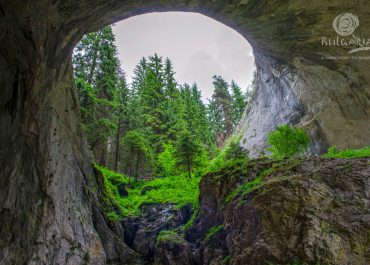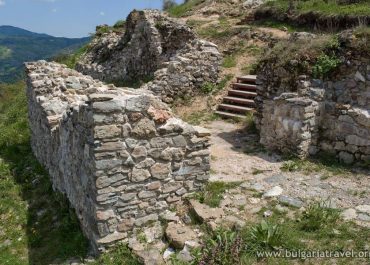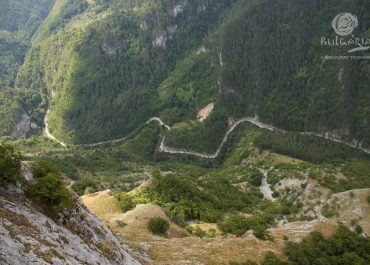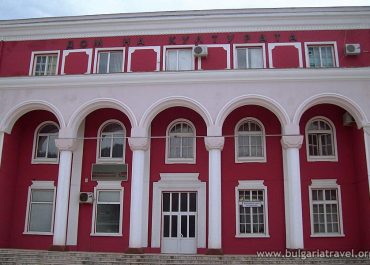
The Trigrad Gorge
The Trigrad Gorge is a 7-kilometer defile north of the village Trigrad, beneath towering marble cliffs cut over millions of years by the Trigrad River. The gorge was declared a protected reserve by Decree № 4021 on December 6, 1963.
In places, the cliffs are some 300 meters apart, but in a considerable portion of the gorge, for some 2-3 km, they are only separated by about 100 meters. On the western side of the gorge, the cliffs rise roughly 180 meters, while on the east they are 300-350 meters high. These gargantuan dimensions place the gorge third among all such geological formations in Bulgaria. The road to Trigrad winds along the river that in places pours from the rocks. It is a typical Bulgarian one-lane mountain road, with traffic in both directions. To drive this narrow, winding road requires considerable attention and tolerance, since cars traveling in opposite directions can’t pass each other. Because this narrow road is squeezed between the river on one side and the sheer cliffs on the other, travelers get the impression that Trigrad is much more distant than it is, and that the village is guarded by stone fortress walls closely guarding the mountain’s secrets. The massive cliffs that toward the upper part of the road seem to almost touch each other, that seem to steal the very sunlight, present visitors with a humbling sight, and the considerable natural beauty of the surrounding Rhodopes completes the unforgettable picture. The Trigrad River disappears into the earth at the entrance to The Devil’s Throat Cave, only to reappear some 530 meters below in a different cave. The Devil’s Throat Cave is a favorite tourist destination and one of the country’s most impressive developed caves, in part because of its huge waterfall fed by the river – a 42-meter drop. There are many other caves in the area, but most of them are relatively small (only 12 are more than 100 meters long). A particularly interesting cave for tourists is the Haramiyska Cave on the cliff face opposite The Devil’s Throat Cave. Remains from Neolithic cave dwellers have been discovered there. However, the cave can only be visited with the use of climbing and spelunking equipment and accompanied by an experienced guide. Not far from these caves is the beautiful Yagodina Cave. The road through the Trigrad Gorge leads to the picturesque village of Trigrad, where tourists will find a warm welcome. The village offers overnight accommodations and can arrange other tourist activities. Near the village, there are a number of hiking trails that allow visitors to further appreciate the beauty of the region.
The gorge is located to the north of Trigrad village, and the road to Trigrad traverses it.
Tourist information center – Smolyan
Every day: 8:30-12:00; 12:30-17:00
bul. “Bulgaria” № 5
Tel: +359 301 62530
E-mail: toursmolyan@abv.bg
Website: www.smolyan.bg
The Yagodina Rhodopes Tourist Association
Tel: +359 3041 92 00
The Trigrad Gorge is a 7-kilometer defile north of the village Trigrad, beneath towering marble cliffs cut over millions of years by the Trigrad River. The gorge was declared a protected reserve by Decree № 4021 on December 6, 1963.
In places, the cliffs are some 300 meters apart, but in a considerable portion of the gorge, for some 2-3 km, they are only separated by about 100 meters. On the western side of the gorge, the cliffs rise roughly 180 meters, while on the east they are 300-350 meters high. These gargantuan dimensions place the gorge third among all such geological formations in Bulgaria. The road to Trigrad winds along the river that in places pours from the rocks. It is a typical Bulgarian one-lane mountain road, with traffic in both directions. To drive this narrow, winding road requires considerable attention and tolerance, since cars traveling in opposite directions can’t pass each other. Because this narrow road is squeezed between the river on one side and the sheer cliffs on the other, travelers get the impression that Trigrad is much more distant than it is, and that the village is guarded by stone fortress walls closely guarding the mountain’s secrets. The massive cliffs that toward the upper part of the road seem to almost touch each other, that seem to steal the very sunlight, present visitors with a humbling sight, and the considerable natural beauty of the surrounding Rhodopes completes the unforgettable picture. The Trigrad River disappears into the earth at the entrance to The Devil’s Throat Cave, only to reappear some 530 meters below in a different cave. The Devil’s Throat Cave is a favorite tourist destination and one of the country’s most impressive developed caves, in part because of its huge waterfall fed by the river – a 42-meter drop. There are many other caves in the area, but most of them are relatively small (only 12 are more than 100 meters long). A particularly interesting cave for tourists is the Haramiyska Cave on the cliff face opposite The Devil’s Throat Cave. Remains from Neolithic cave dwellers have been discovered there. However, the cave can only be visited with the use of climbing and spelunking equipment and accompanied by an experienced guide. Not far from these caves is the beautiful Yagodina Cave. The road through the Trigrad Gorge leads to the picturesque village of Trigrad, where tourists will find a warm welcome. The village offers overnight accommodations and can arrange other tourist activities. Near the village, there are a number of hiking trails that allow visitors to further appreciate the beauty of the region.
The gorge is located to the north of Trigrad village, and the road to Trigrad traverses it.
Tourist information center – Smolyan
Every day: 8:30-12:00; 12:30-17:00
bul. “Bulgaria” № 5
Tel: +359 301 62530
E-mail: toursmolyan@abv.bg
Website: www.smolyan.bg
The Yagodina Rhodopes Tourist Association
Tel: +359 3041 92 00
Virtual map
Photos
© All images, advertising and video materials and/or other information published on this website are property of the Ministry of Tourism and are protected by the Law on Copyright and Related Rights, according to the Bulgarian laws to all applicable international and relevant acts of the European Union.





